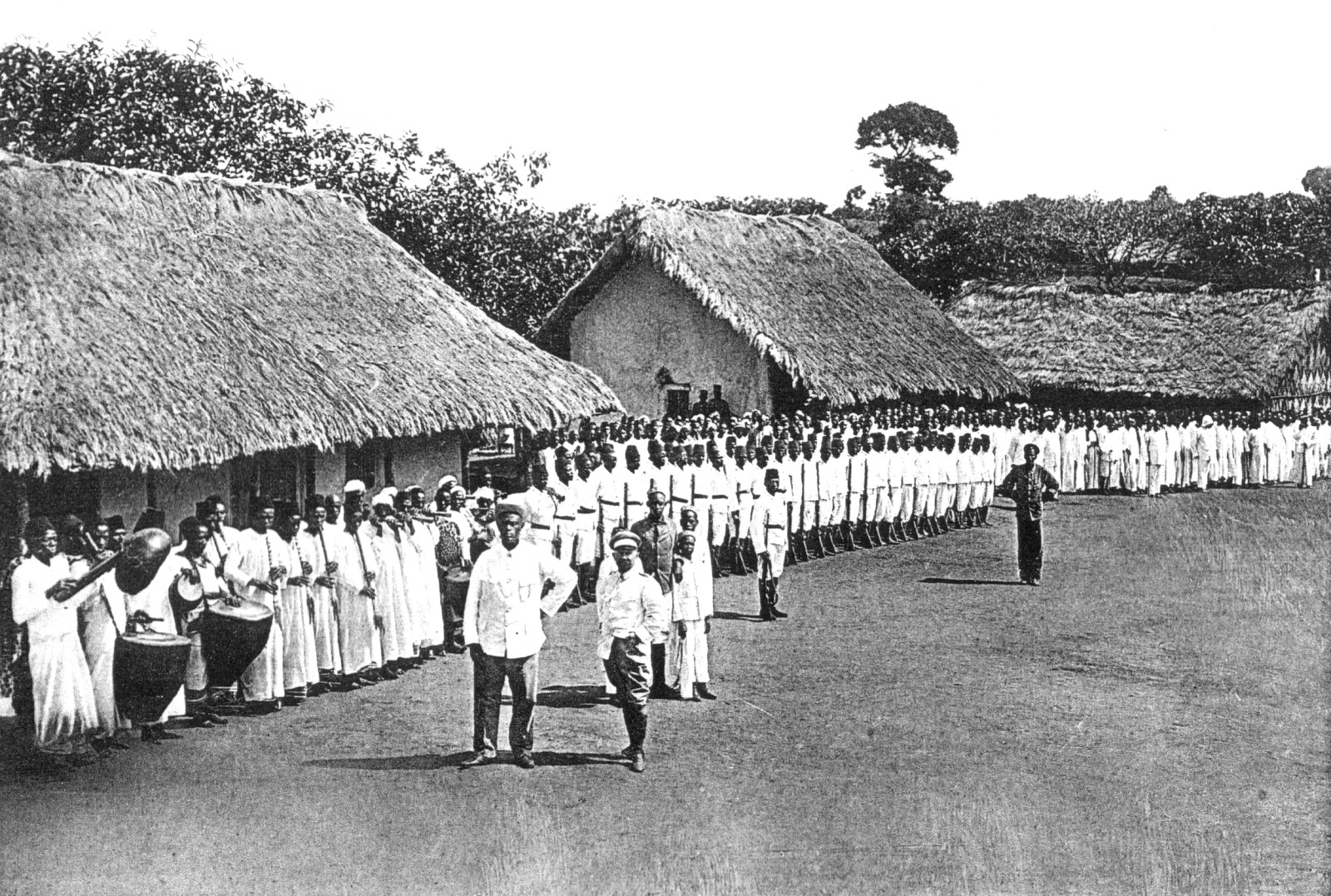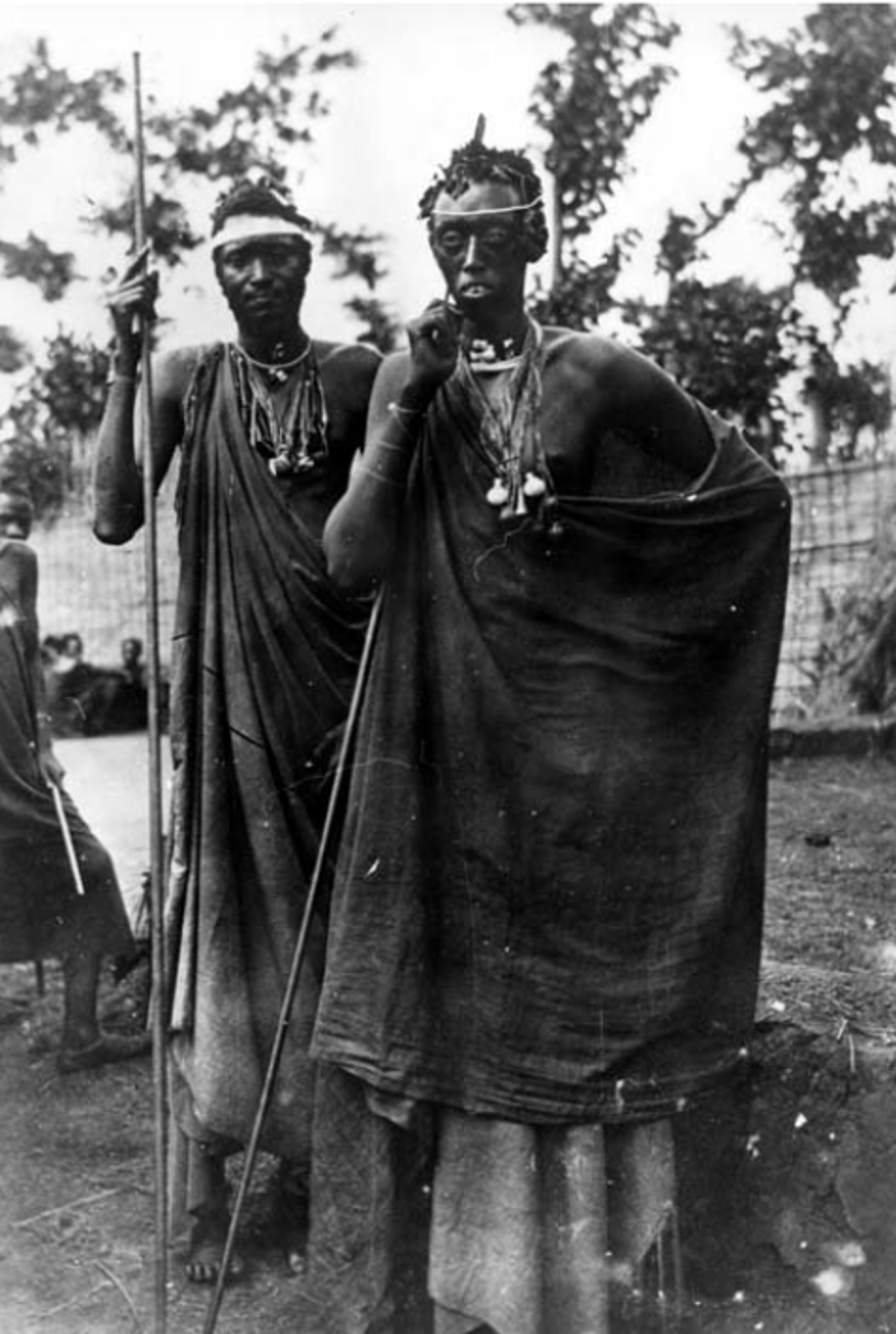Kahigi of Kianja
 |
| Kahigi of Kianja photgraphed by the missionary Johanssen (1915) |
So, I will start
with pictures of Kahigi of Kianja. He was the ruler of one of the
successor states of the Greater Kiamtwara empire, which felt apart
shortly before the arrival of the Germans in 1890. Kahigi's territory
was the smallest of the emerging successor kingdoms, and his rule was
constantly contested by raids of the neighboring kingdoms. To stop
these raids and to preserve his throne he had to pay tribute to his
neighbors as well as to the Bugandans, then the regional hegemonic
power. When Germans arrived in 1891 in the region, Kahigi welcomed
them as allies in the ongoing struggle for dominance in the region.
He was among the first local rulers to offer his services to the
boma, as the Germans called their military stations, and within a
decade, he rose towards the most powerful kings of the region.

The many costumes of Kahigi: As a officer in a prussian uniform (Source DKG-Archive)

Kahigi as a land-lord (Source: DKG-Archive)
Kahigi's fortune
increased with the arrival of Willibald von Stuemer as the new
official at the boma of Bukoba in 1906. Kahigi of Kianja successively
extended his sphere of influence over neighboring kingdoms and was
even awarded by the Germans for his cooperation with some territory
of his rivals. Kahigi used his alliance with the Germans and the
proximity of his court to the boma of Bukoba to establish his court
as an important diplomatic center of the region. The court of Kianja
became a place where Germans banished some political dissidents from
other regions. It allowed Kahigi to step into the old game of
manipulating political dissidents for his own aims. Moreover, when
Bukoba became a new entrepot of trade with Ruanda and Burundi and
with Buganda, he profited from the new trade routes. He also became
engaged in the cultivation of coffee and other cash crops.

Kahigi of Kianja and Willibald von Stuemer during the visit of the Herzog of Mecklemburg (Source: Czekanowski 1911)
Kahigi and Stuemer developed some sort of a working relationship which was profitable to both of them. While Kahigi became more powerful and richer with every year in power, Stuemer soon was handled as the colony's most successful colonial administrator. For the Germans, notably for the governor Count von Götzen and his successor Rechenberg, Kahigi's cooperation with the Stuemer became the model of German colonial politics in the region and beyond. When the Secretary of the State for Colonial affairs, Bernhard Dernburg visited the colony, he was also a guest at Kahigi's residence. The reception was carefully orchestrated by Kahigi and Stuemer and seemed to have convinced Dernburg. In the aftermath of his visit, Dernburg took not only on the British Indirect Rule in Buganda, but also its German version at Bukoba as a blueprint for reforms of colonial politics of the Empire.

"The sultan's harem", the title in Czekanowskis book promises to the reader. Taken at the same occasion (Source: Czekanowski 1911)

Kahigi and the commander of the Schutzruppe von Schleinitz (on the right?), ca. 1908 (Source: DKG-Archive)

Kahigi and his court. On the left you see his ruga-ruga and his advisers, ca. 1908 (Source: DKG-Archive)
Kahigi died in
unexplained circumstances shortly afer the Germans left the region
during the First World War.
So, I will start
with pictures of Kahigi of Kianja. He was the ruler of one of the
successor states of the Greater Kiamtwara empire, which felt apart
shortly before the arrival of the Germans in 1890. Kahigi's territory
was the smallest of the emerging successor kingdoms, and his rule was
constantly contested by raids of the neighboring kingdoms. To stop
these raids and to preserve his throne he had to pay tribute to his
neighbors as well as to the Bugandans, then the regional hegemonic
power. When Germans arrived in 1891 in the region, Kahigi welcomed
them as allies in the ongoing struggle for dominance in the region.
He was among the first local rulers to offer his services to the
boma, as the Germans called their military stations, and within a
decade, he rose towards the most powerful kings of the region.
 |
| The many costumes of Kahigi: As a officer in a prussian uniform (Source DKG-Archive) |
 |
| Kahigi as a land-lord (Source: DKG-Archive) |
Kahigi's fortune
increased with the arrival of Willibald von Stuemer as the new
official at the boma of Bukoba in 1906. Kahigi of Kianja successively
extended his sphere of influence over neighboring kingdoms and was
even awarded by the Germans for his cooperation with some territory
of his rivals. Kahigi used his alliance with the Germans and the
proximity of his court to the boma of Bukoba to establish his court
as an important diplomatic center of the region. The court of Kianja
became a place where Germans banished some political dissidents from
other regions. It allowed Kahigi to step into the old game of
manipulating political dissidents for his own aims. Moreover, when
Bukoba became a new entrepot of trade with Ruanda and Burundi and
with Buganda, he profited from the new trade routes. He also became
engaged in the cultivation of coffee and other cash crops.
 |
| Kahigi of Kianja and Willibald von Stuemer during the visit of the Herzog of Mecklemburg (Source: Czekanowski 1911) |
Kahigi and Stuemer developed some sort of a working relationship which was profitable to both of them. While Kahigi became more powerful and richer with every year in power, Stuemer soon was handled as the colony's most successful colonial administrator. For the Germans, notably for the governor Count von Götzen and his successor Rechenberg, Kahigi's cooperation with the Stuemer became the model of German colonial politics in the region and beyond. When the Secretary of the State for Colonial affairs, Bernhard Dernburg visited the colony, he was also a guest at Kahigi's residence. The reception was carefully orchestrated by Kahigi and Stuemer and seemed to have convinced Dernburg. In the aftermath of his visit, Dernburg took not only on the British Indirect Rule in Buganda, but also its German version at Bukoba as a blueprint for reforms of colonial politics of the Empire.
 |
| "The sultan's harem", the title in Czekanowskis book promises to the reader. Taken at the same occasion (Source: Czekanowski 1911) |
 |
| Kahigi and the commander of the Schutzruppe von Schleinitz (on the right?), ca. 1908 (Source: DKG-Archive) |
 |
| Kahigi and his court. On the left you see his ruga-ruga and his advisers, ca. 1908 (Source: DKG-Archive) |
Kahigi died in
unexplained circumstances shortly afer the Germans left the region
during the First World War.



This comment has been removed by the author.
ReplyDeleteGreat Journal. As a native of Bukoba (Lesser Kyamutwara Kingdom) I am deeply touched with your posts depicting the lives and interpretations from images captures by the German Colonisers. One wonders, how what fate those Kingdoms (large and small) and their people would have had had Europeans not showed up in their midst. Thanks again.
ReplyDeleteThis is a starting point for reconstruction of Buhaya history about Kianja and Kahigi seems there are many things still needs to be investigated
ReplyDeleteHi ? Kahigi had haw many children and where did they end up .most probably Bamuhiga was one of them
ReplyDeleteBamuhiga ended up in nkore
ReplyDeleteHe is my great grandfather
ReplyDeleteOur family still exists and his grandson is also still alive living in bukoba currently
ReplyDelete